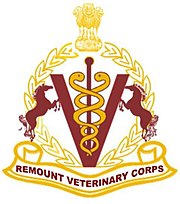
The German Shepherd or Alsatian is a German breed of working dog of medium to large size. The breed was developed by Max von Stephanitz using various traditional German herding dogs from 1899.

The Bulldog is a British breed of dog of mastiff type. It may also be known as the English Bulldog or British Bulldog. It is a medium sized, muscular dog of around 40–55 lb (18–25 kg). They have large heads with a thick folds of skin around the face and shoulders, and a relatively flat face with a protruding lower jaw. The breed has significant health issues as a consequence of breeding for its distinctive appearance, including brachycephalia, hip dysplasia, heat sensitivity, and skin infections. Due to concerns about their quality of life, breeding Bulldogs is illegal in Norway and the Netherlands.

The Arabian or Arab horse is a breed of horse that originated on the Arabian Peninsula. With a distinctive head shape and high tail carriage, the Arabian is one of the most easily recognizable horse breeds in the world. It is also one of the oldest breeds, with archaeological evidence of horses in the Middle East that resemble modern Arabians dating back 4,500 years. Throughout history, Arabian horses have spread around the world by both war and trade, used to improve other breeds by adding speed, refinement, endurance, and strong bone. Today, Arabian bloodlines are found in almost every modern breed of riding horse.

The Indian Army is the land-based branch and the largest component of the Indian Armed Forces. The President of India is the Supreme Commander of the Indian Army, and its professional head is the Chief of Army Staff (COAS), who is a four-star general. Two officers have been conferred with the rank of field marshal, a five-star rank, which is a ceremonial position of great honour. The Indian Army was formed in 1895 alongside the long established presidency armies of the East India Company, which too were absorbed into it in 1903. The princely states had their own armies, which were merged into the national army after independence. The units and regiments of the Indian Army have diverse histories and have participated in several battles and campaigns around the world, earning many battle and theatre honours before and after Independence.

The Indo-Tibetan Border Police (ITBP) is a border patrol organization of India deployed along its borders with Tibet Autonomous Region. It is one of the seven Central Armed Police Forces, established in 1962 in the aftermath of the Sino-Indian War of 1962.

The Lipizzan or Lipizzaner, is a European breed of riding horse developed in the Habsburg Empire in the sixteenth century. It is of Baroque type, and is powerful, slow to mature and long-lived; the coat is usually gray.

The Exmoor Pony is a British breed of pony or small horse. It is one of the mountain and moorland pony breeds native to the British Isles, and so falls within the larger Celtic group of European ponies. It originates on, and is named for, the Exmoor area of moorland in north-eastern Devon and western Somerset, in south-west England, and is well adapted to the climate conditions and poor grazing of the moor. Some still live there in a near-feral state, but most are in private ownership.

The Mudhol Hound, also known variously as the Maratha Hound, the Pashmi Hound, the Kathewar Dog and the Caravan Hound, is a breed of sighthound from India.
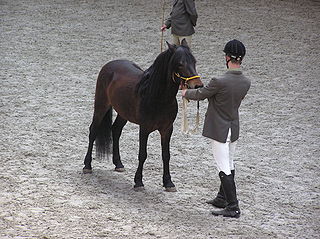
The Hucul or Carpathian is a pony or small horse breed originally from the Carpathian Mountains. It has a heavy build and possesses great endurance and hardiness. The breed is also referred to as the Carpathian pony, Huculska, Hutsul, Huțul, Huțan or Huzul. The breed gets its name from the Hutsul people, who live mostly in the Carpathians in Ukraine and in Romania, but also in an area in the East Carpathian Mountains north of the river Bistritz, officially named “Huzelei”.
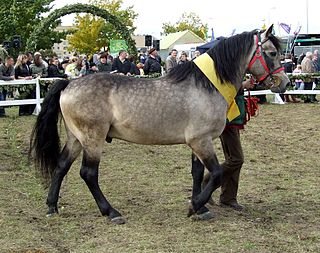
The Žemaitukas is a historic horse breed from Lithuania. It may be classified as a pony, due to its relatively short stature. Known from the 6–7th centuries, it was used as a war horse by the Lithuanians during the Northern Crusades and is hailed in Lithuania as part of the state's historic heritage. Its origin is uncertain; it is related to the Estonian Native and the Konik. The breed contributed to the foundation of the Trakehner. Once popular, the breed was brought to the brink of extinction by changing agricultural demands and World War II. As of 2010, the total population is estimated at 400 individuals.

The Royal Army Veterinary Corps (RAVC), known as the Army Veterinary Corps (AVC) until it gained the royal prefix on 27 November 1918, is an administrative and operational branch of the British Army responsible for the provision, training and care of animals. It is a small corps, forming part of the Army Medical Services.

The Zaniskari or Zanskari is a breed of small mountain horse or pony from Ladakh, in northern India. It is named for the Zanskar valley or region in Kargil district. It is similar to the Spiti breed of Himachal Pradesh, but is better adapted to work at high altitude. Like the Spiti, it shows similarities to the Tibetan breeds of neighbouring Tibet. It is of medium size, and is often grey in colour. The breed is considered endangered, as there are only a few hundred alive today, and a conservation programme has been started at Padum, Zanskar, in the Kargil district of Ladakh.
The Indian Defence services have established numerous academies and staff colleges across India for the purpose of training professional soldiers in military sciences, warfare command and strategy, and associated technologies.
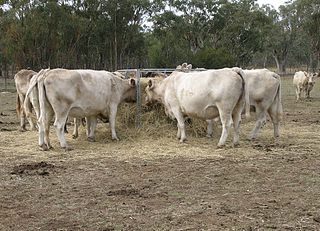
A stud animal is a registered animal retained for breeding. The terms for the male of a given animal species usually imply that the animal is intact—that is, not castrated—and therefore capable of siring offspring. A specialized vocabulary exists for de-sexed animals and those animals used in grading up to a purebred status.

The Bakharwal dog is found in northern India. It is an ancient working Indian dog breed found in Ladakh and across the Pir Panjal Range of India, where it has been bred for many centuries by the Bakarwal and Gujjar nomadic tribes, as a livestock guardian dog and settlement protector. While the Bakharwal Dog is mainly found in India, it is found in smaller numbers in Afghanistan and Pakistan.
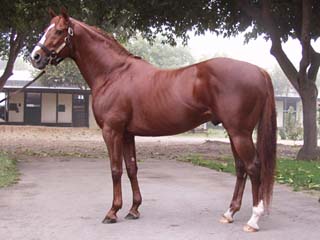
The Thoroughbred is a horse breed developed for horse racing. Although the word thoroughbred is sometimes used to refer to any breed of purebred horse, it technically refers only to the Thoroughbred breed. Thoroughbreds are considered "hot-blooded" horses that are known for their agility, speed, and spirit.
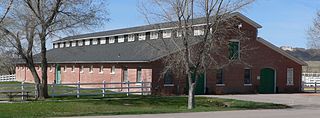
A part of the Quartermaster Corps, the U.S. Army Remount Service provided horses as remounts to U.S. Army units. Evolving from both the Remount Service of the Quartermaster Corps and a general horse-breeding program under the control of the Department of Agriculture, the Remount Service began systematically breeding horses for the United States Cavalry in 1918. It remained in operation until 1948, when all animal-breeding programs returned to Department of Agriculture control.
The Army Remount Service was the body responsible for the purchase and training of horses and mules as remounts for the British Army between 1887 and 1942.

The Bhimthadi or Deccani horse is an almost extinct breed of Indian horses. It was developed in Pune district in 17th and 18th centuries during the Maratha rule by crossing Arabian and Turkic breeds with local horse breed.
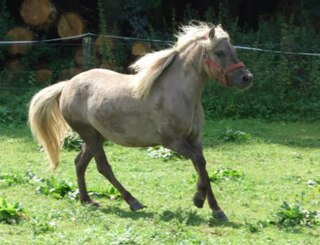
The German Classic Pony or German: Deutsches Classic-Pony is a modern German breed of riding pony. It derives from the traditional Shetland Pony of the Scottish Shetland Isles, but is principally influenced by the taller and more elegant American Shetland Pony.
